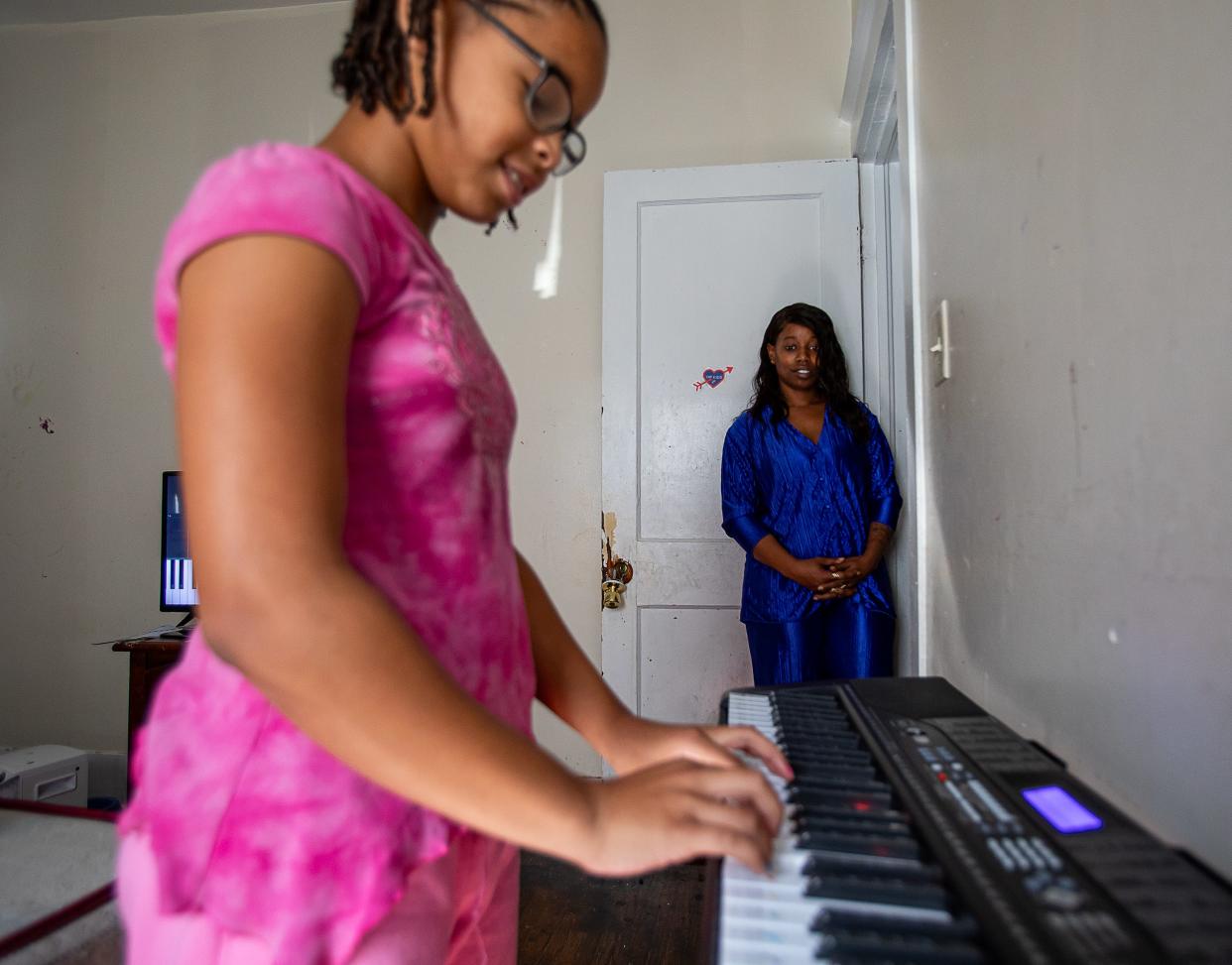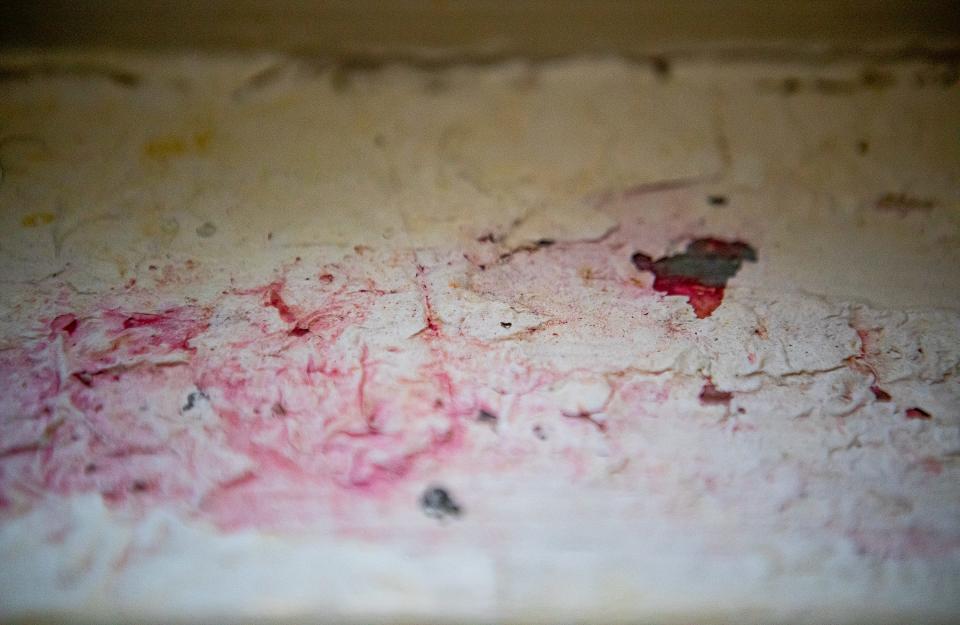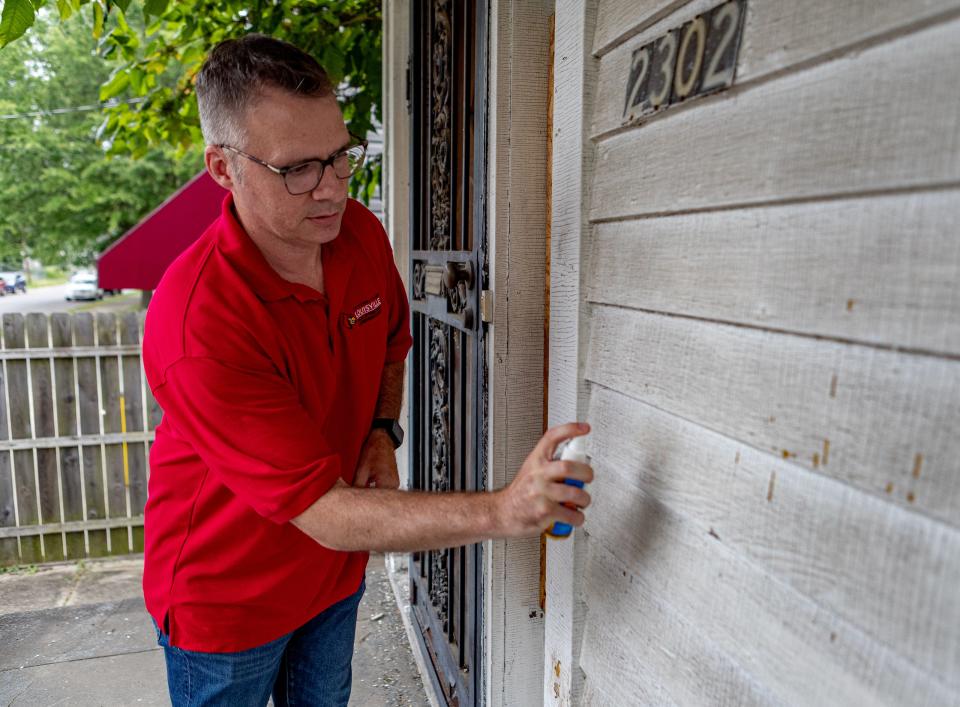'Not a level playing field': Why some Louisville areas are at a higher risk of lead poisoning

Editor’s note: This is Part 4 of “A Heavy Burden,” a five-part investigation into Louisville’s ongoing problem with childhood exposure to lead paint. What is often thought to be a 20th century problem is still very real in 2023. Nearly 10,000 local children tested with high lead levels in their blood over the past two decades, and kids are still at risk today. A new law, still a year away from implementation, aims to right this wrong.
On a pleasant October afternoon in Louisville's Shawnee neighborhood, Devaeh Snellen, 10, sat in her bedroom playing Beethoven’s “Für Elise.”
“When she was… I don't know, 7, 8 months, she started banging on the piano,” said her mother, Kwmisha Adams, as the notes chimed through the air. “I really hope I can get myself in a situation where I can afford to pay for a piano teacher.”
Adams has five children, whose ages range from 6 months to 11 years old. More than anything, she wants them to succeed.
“I definitely want them to go farther,” she said. “Farther than I did.”
Adams and her children live in one of the ZIP codes identified to be at the highest risk for lead in Louisville, according to research by University of Louisville epidemiology professor Brian Guinn.
But it’s not just a dreaded hypothetical for Adams.
Lead, in the form of aged paint, hides throughout the house. The neurotoxin lurks on the front door frame and interior walls, and lingers on the windowsill over the kitchen sink.

Section 8 housing, where low-income tenants get help from the federal government to pay the rent, is often older, said attorney Grace Chambers, who works in the Legal Aid Society's child advocacy program.
“They're going to be old, with lead,” she said. “It's going to have potential for mold because the building's old, and they don't address it the way it needs to be addressed… And the folks are stuck reporting to code enforcement. I believe their landlord’s response is normally just a Band-Aid on a bullet wound. It is not an actual substantive fix, and it keeps coming back.”
Children who live in Louisville's northwest corner are over nine times more likely to be lead poisoned than children in other parts of Jefferson County, according to an analysis conducted by Guinn. Disproportionate lead exposure was mentioned earlier this year by the U.S. Department of Justice in its critical report about Louisville police misconduct.
Lead exposure is particularly damaging to young, developing brains. It affects cognition and can cause learning difficulties. Lead is also associated with a decrease in decision-making ability and risk assessment.
“It's well documented that lead exposure in childhood is a risk factor for being a victim of violence or committing acts of violence later on in life,” said Dr. Kyle Fischer, an emergency physician at the University of Maryland School of Medicine who also serves as the policy director for a violence intervention group.
While it's possible for children to have successful, peaceful lives after being lead-poisoned, it can create another barrier for kids who already face challenges to succeed.
“If you've been blasted by lead for a decade,” Guinn said, “it's not a level playing field.”
'Exposure to lead is driving educational inequity'
Childhood lead exposure can affect learning, speech, hearing and behavior — all benchmarks that educators use as a child progresses through school.
It can impact IQ scores, create attention difficulties and result in decreased school performance, according to the U.S. Centers for Disease Control and Prevention.
“That doesn't mean those students can't learn,” said Brent McKim, president of the Jefferson County Teachers Association. “But it does mean that they're probably going to need greater support, both in terms of academics and in terms of their own personal health, to be able to be successful and to help level the playing field.”

Research shows students exposed to lead score lower on standardized tests than their counterparts.
McKim wrote a letter of support for a new Louisville ordinance that aims to address lead by creating a registry of rental properties. He cited a study from Duke University that showed Black students are more likely to be exposed to lead, and exposure is a significant factor in the test score gap between white and Black students.
“The evidence is clear: Exposure to lead is driving educational inequity,” McKim wrote.
But symptoms of lead poisoning overlap with those of other health issues, making it sometimes difficult to pinpoint as the cause of behavioral and cognitive struggles.
If a child does test with elevated blood lead levels, their teacher may never know unless a parent willingly informs them, McKim said.
“They just know this kid maybe has learning challenges or behavioral challenges or often both and don't have any way to connect the dots,” he said.
This is part of the reason lead contamination has been a vexing problem for Louisville and other cities.
“It's invisible,” said state Sen. Cassie Chambers Armstrong, who sponsored the new lead ordinance when she was a Metro Council member. “When your child is poisoned by lead, it's not that they fall on the floor and have a seizure. It's that slowly, over time, it literally eats away at their brain in a way that steals their future.”
Redlining of the past matches up with today's lead risk
While a 2014 state assessment designated five ZIP codes in Louisville to be “at risk” for lead poisoning, Guinn’s research found double the amount. The 10 ZIP codes he found are 40212, 40211, 40210, 40203, 40208, 40215, 40204, 40217, 40221 and 40209. They stretch from the West and South ends out to Eastern Parkway, the Highlands and around Churchill Downs.
Many of the areas most at risk for lead exposure are also the ones delineated in the 1930s "redlining" maps.
Redlining refers to the Home Owners Loan Corp.'s former practice of grading neighborhoods from “A” to “D.”
Race and wealth were factored into the score, meaning neighborhoods with people of color, immigrants, and low-income residents were often given “C” or “D” ratings. This affected residents' ability to receive home loans and build credit, which impacted generational wealth and had a ripple effect that spans to today.
“People weren't given home loans, and it created poverty,” Guinn said. “I don't think it's any mystery or secret why poverty is associated with lead poisoning. It just comes down to dollars and cents.”
While lead paint from the past is often painted over, when that paint chips away, it can reveal the dormant poison underneath. Maintaining the encapsulation requires attention and money — if you know the lead is there at all.
Pre-1978 housing is the epicenter of where lead is most likely to be lurking. Those on Section 8 vouchers, including Adams, are likely to end up in older, less maintained housing stock.
And that's left Adams wondering what to do next.
“As of right now, I don't have a plan. I ... have nowhere to go. I don't have very much help,” Adams said. “I don't have a choice but to stay here.”
She said she intends to confront her landlord over the lead paint issue, as well as other maintenance problems, but she feels like she has to make the choice between unsafe housing and none at all.
“The issue is going to be concentrated in the West and South because of all the urban planning issues and redlining,” said Gabriell Gassaway, the research core director of the University of Louisville Health Equity Innovation Hub.
But she warns people not to think of lead as a “poor person’s problem” or a “Black person’s problem,” she said.
Guinn agreed.
“I go into my friend's homes, they live in the Highlands, they have six-figure jobs, they drive nice cars. They have lead paint on their windowsills, and I'm like, ‘That's lead paint right there,’ and they have no idea.”
For some neighborhoods, lead not the only environmental factor

Guinn stands on the porch of a 100-year-old home in the California neighborhood, poison all around him.
Plywood sheets cover the windows, vegetation has begun to swallow the left side, and a layer of lead paint is chipping from every surface like scales.
No one has regularly lived in this house, currently owned by the city, in at least a decade, a neighbor said. But while the house is here, covered top to bottom in lead, it’s a risk to the community.
Unhoused people take shelter in abandoned properties, and children may play outside on the lot. Guinn said he’s found half-built Lego sets and other toys sitting on lead-covered porches on his sampling trips.
This particular home is around the corner from Victory Park, in an area where an estimated 90% of homes were built before 1960 and the childhood lead exposure risk is exceedingly high. But lead is one of many environmental factors working in tandem against human health here.
Some are more obvious, like the endless stream of tractor-trailers chugging by on the interstate, or the omnipresent odor of sewer gas. Others, like lead, are more subtle.
Life expectancies in parts of the West End are about a decade shorter than parts of eastern Jefferson County. In some of the neighborhoods in the west, abutting the city’s largest cluster of chemical plants, rates of heart disease, diabetes or asthma are around the top 1% nationally, according to federal data.
Some of these same communities are among Louisville’s most lead-laden, but they also bear the brunt of the city’s industrial pollution.
In 2022 alone, chemical emissions into Louisville’s air, water and soil totaled 2.9 million pounds, according to a Courier Journal analysis of the EPA’s Toxics Release Inventory data. And each year, this inventory shows emissions of cancer-causing and neurotoxic chemicals disproportionately afflicting the low-income communities and communities of color in Louisville's south and west sides.
About 4,500 pounds of lead were emitted into the air by industrial facilities over the past decade, according to the inventory, and another 340,000 pounds were discharged to Louisville’s soil.
But dozens of other chemicals are polluting the air, each with their own toxic effects. They act on the human body cumulatively, but are regulated individually — a framework long criticized by environmental justice advocates in Louisville and beyond.
Other factors pile on to the disparity. Much of south and west Louisville suffer from food deserts, and poor nutrition increases a child’s vulnerability to lead poisoning.
Adequate calcium, iron and vitamin C can help slow the body's absorption of lead and its toxicity. These nutrients, often found in fresh fruits and vegetables, meat and dairy, may be out of reach for families, whether due to grocery store access or budget constraints.
“When a child has an elevated blood (lead) level, part of what is recommended … is making sure that that child has a healthy diet,” said Kristina Bryant, associate medical director for the public health department and an infectious disease specialist at Norton Children's. “That's a disparity in our community. Not every child in our community may have access to a nutritious diet.”
The cruel medley of health impacts facing Louisville’s poorest neighborhoods is often amplified by a lack of access to health care.
But clinics supporting the West End, including Park DuValle Community Health Centers and Shawnee Christian Healthcare Center, are working to fill those gaps. And Norton’s new facility at 28th and Broadway, sharing a campus with Goodwill and its services, will be the first hospital built west of Ninth Street in more than a century.
Read the previous story: Louisville's lead-poisoned children are neglected as testing plummets by 80%
Read the next story '100% preventable': Louisville has a path to end childhood lead exposure
This article originally appeared on Louisville Courier Journal: Areas of Louisville with more risk for child lead paint poisoning

